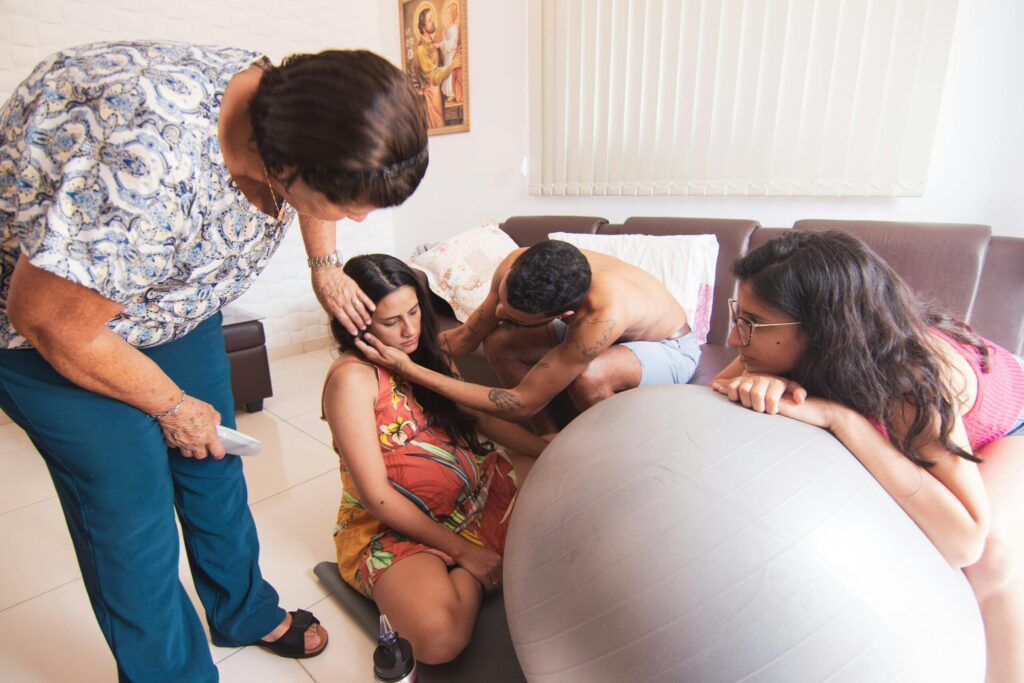As a mother of five children and a midwife with over two decades of experience, I’ve guided countless women through their postpartum recovery journey. One of the most common concerns new mothers have is about postpartum bleeding—what’s normal, what’s not, and how to manage it. Let me walk you through everything you need to know about lochia and postpartum bleeding with both professional expertise and the compassion of someone who’s been exactly where you are now.
Understanding Your Postpartum Recovery Journey
The moment you hold your precious baby in your arms marks the beginning of an incredible new chapter in your life. But your body is just starting its healing process after the remarkable feat of pregnancy and birth. One significant aspect of this healing involves postpartum bleeding, also known as lochia.
I remember after the birth of my first child, despite my training as a midwife, I was surprised by the amount and duration of my postpartum bleeding. Even with professional knowledge, experiencing it personally gave me a whole new perspective on this important postpartum recovery journey.
What Is Lochia and Why Does It Happen?
Lochia is the medical term for the vaginal discharge you experience after giving birth. This discharge consists of blood, mucus, and tissue from the uterine lining that supported your baby during pregnancy. As your uterus begins the remarkable process of returning to its pre-pregnancy size (a process called involution), it sheds this lining, resulting in what appears similar to a heavy period.
According to the American College of Obstetricians and Gynecologists, lochia is a normal and necessary part of your body’s natural healing process. Your body is incredibly wise—this discharge helps clear out the uterus and prevents infection as you heal from the inside out.
The Three Stages of Postpartum Bleeding
Throughout my years supporting new mothers, I’ve found that understanding the typical progression of lochia helps women feel more confident in recognizing what’s normal during their postpartum recovery journey. Let me guide you through what to expect.
Lochia Rubra: The First Phase
Lochia rubra is the initial bleeding you’ll experience, typically lasting about 3-5 days after birth. This discharge is bright red in color and may contain small clots. During my first postpartum experience, I remember being surprised by how similar it was to a very heavy period.
The flow is usually heaviest in the first 24 hours after delivery and gradually decreases over the following days. You might notice the flow becomes heavier when you’re physically active or during breastfeeding sessions (when your uterus contracts). With my third baby, I noticed my bleeding would temporarily increase every time I nursed—a perfectly normal response as those contractions help your uterus return to its pre-pregnancy size.
Lochia Serosa: The Transition Phase
Around day 5 to about day 14 postpartum, the bleeding typically transitions to lochia serosa. During this phase, the discharge becomes pinkish or brownish and is thinner and watery in consistency. This indicates your healing is progressing normally as your body continues its postpartum recovery journey.
With my second child, I remember feeling relieved when I noticed this color change, knowing my body was moving through the normal healing phases. The volume generally decreases during this time, though you’ll still need maternity pads for absorption.
Lochia Alba: The Final Phase
The final phase, lochia alba, typically begins around 2-3 weeks postpartum and may continue until about 6 weeks after delivery. During this stage, the discharge becomes creamy white or yellowish in color. It’s much lighter in flow but may continue intermittently for several weeks.
I often tell the mothers in my practice that this last phase is like your body’s final cleanup crew, making sure everything is properly healed before concluding your immediate postpartum recovery journey.
Managing Your Postpartum Bleeding Effectively
Having experienced postpartum bleeding five times myself, I’ve learned some practical approaches to managing this natural process comfortably. Here are my tried-and-true recommendations for navigating this aspect of your recovery with greater ease.
Essential Supplies for Comfort
Stock up on high-quality maternity pads before your due date—you’ll want them ready when you return home. Regular menstrual pads aren’t designed to handle lochia’s flow, especially in those first days. During my own recoveries, I found that having plenty of supplies on hand provided tremendous peace of mind.
Consider these essentials for your postpartum recovery journey:
- Extra-absorbent maternity pads (avoid tampons which can introduce infection)
- Soft, breathable cotton underwear (slightly larger than your pre-pregnancy size)
- A peri bottle for gentle cleansing
- Witch hazel pads for soothing comfort
- A small waterproof mat for your bed, especially during those first nights
Practical Tips for Daily Management
Over my years of midwifery practice and my own postpartum experiences, I’ve collected several practical tips that make managing lochia easier:
- Change your pad every 3-4 hours or whenever it becomes saturated
- Always wipe and cleanse from front to back to prevent infection
- Use your peri bottle with warm water after using the bathroom
- Rest frequently, especially during the first week
- Keep track of how quickly you’re saturating pads to monitor your flow
- Elevate your feet when resting to help reduce pressure and flow
I remember with my fourth baby, I tried to do too much too soon and noticed my bleeding increased significantly—nature’s way of telling me to slow down and honor my body’s need for rest during this important postpartum recovery journey.
Promoting Healthy Healing
Your body knows how to heal, but you can support this natural process in several ways:
Nutrition for Recovery: Focus on iron-rich foods to replenish blood loss—leafy greens, lean meats, beans, and fortified cereals can all help maintain healthy iron levels. According to Mayo Clinic research, adequate iron intake is crucial for postpartum recovery and preventing anemia.
Hydration is Key: Drink plenty of water throughout the day. Proper hydration supports tissue healing and helps prevent constipation, which can put pressure on your healing uterus.
Rest When Baby Rests: This age-old advice exists for good reason. Your body needs periods of rest to heal effectively. With my fifth baby, I finally learned to let the housework wait and prioritize naps when my little one slept.
When to Contact Your Healthcare Provider
While postpartum bleeding is normal, certain changes warrant prompt medical attention. Throughout my midwifery career, I’ve emphasized that recognizing these signs is an important part of your postpartum recovery journey.
Red Flags During Your Recovery
Contact your healthcare provider immediately if you experience:
- Bleeding that suddenly becomes heavier rather than gradually decreasing
- Passing clots larger than a plum
- Saturating more than one pad per hour for several consecutive hours
- Bright red bleeding that returns after changing to lighter colors
- Discharge with a foul odor
- Signs of infection such as fever, chills, or intense abdominal pain
With my second baby, I experienced a sudden increase in bright red bleeding about 10 days postpartum. I called my midwife right away, and it turned out I had been overdoing it and needed more rest. That experience taught me firsthand how important it is to monitor your body’s signals during this vulnerable time.
Understanding Secondary Postpartum Hemorrhage
While most heavy bleeding occurs immediately after birth, secondary postpartum hemorrhage—heavy bleeding that occurs 24 hours to 12 weeks after delivery—can sometimes happen. This is often related to pieces of placenta remaining in the uterus or an infection.
In my practice, I’ve cared for women experiencing this complication and remind them that seeking prompt medical care is essential, not something to feel embarrassed about. Your postpartum recovery journey sometimes includes unexpected turns, and getting appropriate care quickly ensures the best outcomes.
Emotional Aspects of Postpartum Bleeding
The physical aspects of recovery often receive the most attention, but the emotional and psychological components of postpartum bleeding deserve acknowledgment too.
Finding Peace with Your Changing Body
For many new mothers, the extended period of bleeding serves as a reminder that healing takes time. In our society that often rushes women to “bounce back” after childbirth, the presence of lochia can feel frustrating.
I encourage the women in my care to view this bleeding as a sacred process—a reminder of the incredible journey their bodies have undertaken. This perspective shift can transform this aspect of your postpartum recovery journey from an inconvenience to a powerful reminder of your body’s wisdom and capability.
Partner Communication and Support
Open communication with your partner about your physical recovery needs is important. Many partners don’t fully understand the nature of postpartum bleeding and may benefit from gentle education.
When my children were born, I found that briefly explaining what was happening with my body helped my partner provide more appropriate support. Whether it’s taking on more household responsibilities, understanding limitations on physical activity, or simply offering emotional encouragement, informed partners can be tremendous allies on your postpartum recovery journey.
The Return to Normal
As your lochia gradually subsides, you’ll begin to feel more like yourself physically. However, it’s important to remember that your first menstrual period after childbirth may be different from what you experienced before pregnancy.
What to Expect When Your Period Returns
If you’re not breastfeeding, your period may return as early as 4-8 weeks after delivery. For breastfeeding mothers, menstruation often resumes more gradually, sometimes not returning until partial weaning occurs.
When your period does return, it might be heavier or lighter than before pregnancy. The timing and nature of your cycles are unique to your postpartum recovery journey, and there’s a wide range of what’s considered normal.
Your New Normal
With each of my five postpartum experiences, I noticed subtle differences in how my body healed and how my cycles eventually returned. Your body has undergone profound changes through pregnancy and birth, and some aspects may never be exactly as they were before.
This isn’t something to fear but rather to acknowledge as part of your evolving story as a woman and mother. The conclusion of your lochia marks an important milestone in your postpartum recovery journey, but remember that healing—both physical and emotional—continues long after the bleeding stops.
Embracing Your Unique Recovery Path
As both a midwife and mother, I’ve witnessed thousands of postpartum recovery stories, each one unique and valid. Your experience with lochia and postpartum bleeding will be as individual as your birth story.
Some women experience lochia for just a few weeks, while others notice intermittent light discharge for up to two months. Some recover their physical energy quickly, while others need more time to feel restored. Whatever your path, know that it’s perfectly normal to have your own timeline for this postpartum recovery journey.
Trust your intuition, honor your body’s signals, and remember that this phase—like all phases of motherhood—is temporary. The bleeding will stop, your energy will return, and this time of intense physical recovery will become a memory as you continue forward in your motherhood journey.
From one mother to another, I wish you gentle healing, patient support, and the wisdom to see this recovery period not just as something to endure but as a sacred time of transformation and renewal as you welcome your little one into the world.



